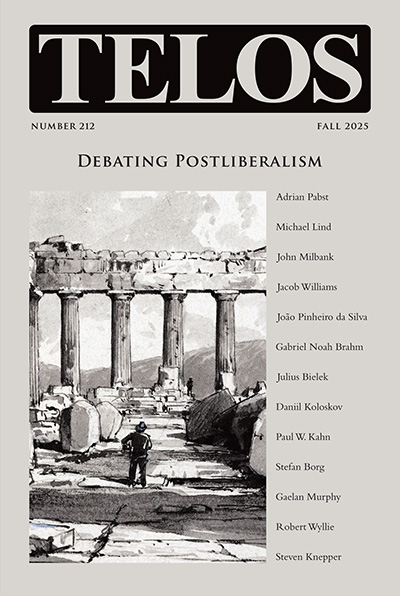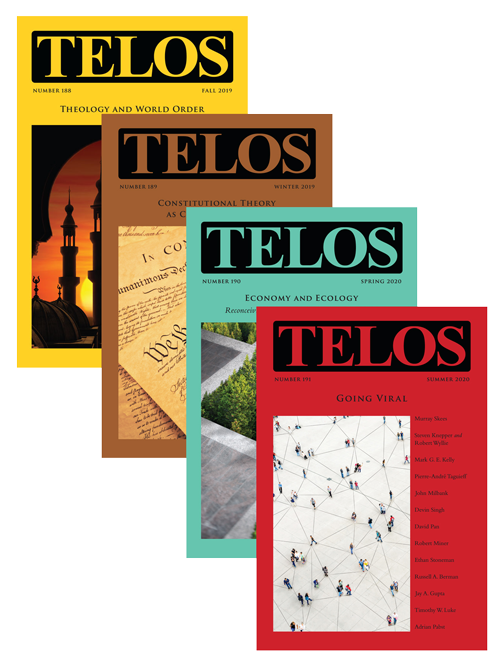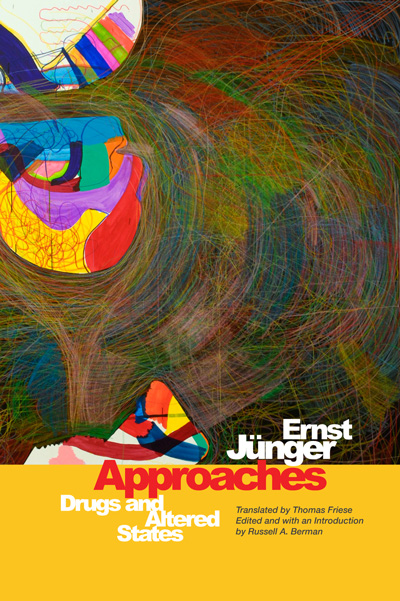By Frederick H. Pitts · Tuesday, July 17, 2012 As an occasional feature on TELOSscope, we highlight a past Telos article whose critical insights continue to illuminate our thinking and challenge our assumptions. Today, Frederick H. Pitts looks at Herbert Marcuse’s “On the Philosophical Foundation of the Concept of Labor in Economics” from Telos 16 (Summer 1973).
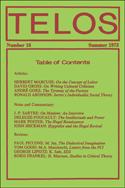 In his 1933 essay “On the Philosophical Foundation of the Concept of Labor in Economics,” Marcuse’s thesis is that the conception of labor as economic activity gives a one-sided picture of human praxis. According to Marcuse, such a conceptualization overlooks the way in which labor is an eternal condition of human existence geared toward self-creation and becoming. Marcuse’s elucidation of these issues invites contention. As Douglas Kellner asserts in his introduction to the essay, the two principal problems with Marcuse’s position pertain to the way in which labor is, on the one hand, presented as an entirely trans- or a-historical phenomenon, capable only of being “liberated” rather than offering the possibility of being “liberated from,” and, on the other, associated with an absolutized self through the process of labor-as-becoming, holding subjectivity to be forged consciously rather than foisted upon oneself from outside (Kellner, 3–6). To these I would add a related third, which is that an economic perspective such as that challenged by Marcuse is necessary to rectify the first and second stumbling blocks. In spite of this, as we shall see, Marcuse’s theorization of the philosophical and economic conceptualization of labor might provide useful insights for a rethink of productive activity in the context of contemporary capitalism. In his 1933 essay “On the Philosophical Foundation of the Concept of Labor in Economics,” Marcuse’s thesis is that the conception of labor as economic activity gives a one-sided picture of human praxis. According to Marcuse, such a conceptualization overlooks the way in which labor is an eternal condition of human existence geared toward self-creation and becoming. Marcuse’s elucidation of these issues invites contention. As Douglas Kellner asserts in his introduction to the essay, the two principal problems with Marcuse’s position pertain to the way in which labor is, on the one hand, presented as an entirely trans- or a-historical phenomenon, capable only of being “liberated” rather than offering the possibility of being “liberated from,” and, on the other, associated with an absolutized self through the process of labor-as-becoming, holding subjectivity to be forged consciously rather than foisted upon oneself from outside (Kellner, 3–6). To these I would add a related third, which is that an economic perspective such as that challenged by Marcuse is necessary to rectify the first and second stumbling blocks. In spite of this, as we shall see, Marcuse’s theorization of the philosophical and economic conceptualization of labor might provide useful insights for a rethink of productive activity in the context of contemporary capitalism.
Continue reading →
By Frederick Wertz · Monday, July 16, 2012 While supporters of the Affordable Care Act are celebrating the late-June decision upholding the constitutionality of the individual mandate, the biggest victory in the decision was for supporters of states’ rights. The sole provision struck down by the Court, Medicaid expansion, marked the first time the Supreme Court halted federal legislation based on the coercion theory. It may be that this somewhat overlooked aspect of the decision will have the greatest impact in future American politics. Coercion theory argues that the federal government can overstep its power by threatening to withhold federal funding if states do not bend to Congress’ will. Since the argument was first used in the 1936, the Court has been largely unwilling to even hear cases citing it as a main argument, and when it has, it has refused to validate the argument. The history of cases argued that cite such alleged coercion sheds much light on this recent decision. By looking closely at the coercion theory, one can see the enormous impact this recently validated argument will have in creating a new, 21st-century federalism.
In 1936, the validity of a tax imposed by the Social Security Act on employers was determined by the Supreme Court. In the case of Steward Machine Co. v. Davis, an Alabama corporation claimed the federal government had levied a tax on employers with the sole
Continue reading →
By Jeffrey S. Librett · Monday, July 16, 2012 Jeffrey S. Librett’s “Historicist Orientalism as a Public Absolute: on Herder’s Typo-teleology” appears in Telos 159 (Summer 2012). Read the full version online at the Telos Online website, or purchase a print copy of the issue here.
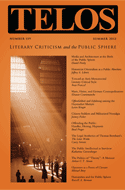 After the Enlightenment attempted to replace the revealed public absolute with a self-grounding universal rationality, an attempt the Counterenlightenment charged with arbitrariness, the historicist discourse tried to establish the narrative of the origin and development of culture as a public, objective absolute that escapes this critique. In this narrative, the Orient functioned as a fetish of origin subserving the disavowal of the lack of grounding that the Enlightenment had introduced. In historicist Orientalism, the Occident appropriated this alien origin by applying the logic of medieval typology—hitherto the principal model for the supersession of Judaism by Christianity—to the Oriental-Occidental relation in general. Historicist Orientalism constituted a typological teleology to assert the supersession of East by West as a quasi-secularized, objective, public absolute. In the anxiety-inducing metaphysical void of modernity, the story of culture provided an “orientation” that revelation failed to deliver. Herder’s Ideas for a Philosophy of the History of Humanity (1784-91) was one of the most important inaugural instances of this historicist Orientalism in the German tradition. The essay retraces the outlines of the problematic logic through which Herder recounted the passage from the origins of culture in Asia to their Western appropriation. Situating the Jews as the realization of the Oriental prefiguration, Herder’s discourse provides an exemplary version of the passage from the Judaeo-Christian application of typology to its Orientalist generalization and secularization. After the Enlightenment attempted to replace the revealed public absolute with a self-grounding universal rationality, an attempt the Counterenlightenment charged with arbitrariness, the historicist discourse tried to establish the narrative of the origin and development of culture as a public, objective absolute that escapes this critique. In this narrative, the Orient functioned as a fetish of origin subserving the disavowal of the lack of grounding that the Enlightenment had introduced. In historicist Orientalism, the Occident appropriated this alien origin by applying the logic of medieval typology—hitherto the principal model for the supersession of Judaism by Christianity—to the Oriental-Occidental relation in general. Historicist Orientalism constituted a typological teleology to assert the supersession of East by West as a quasi-secularized, objective, public absolute. In the anxiety-inducing metaphysical void of modernity, the story of culture provided an “orientation” that revelation failed to deliver. Herder’s Ideas for a Philosophy of the History of Humanity (1784-91) was one of the most important inaugural instances of this historicist Orientalism in the German tradition. The essay retraces the outlines of the problematic logic through which Herder recounted the passage from the origins of culture in Asia to their Western appropriation. Situating the Jews as the realization of the Oriental prefiguration, Herder’s discourse provides an exemplary version of the passage from the Judaeo-Christian application of typology to its Orientalist generalization and secularization.
Continue reading →
By Wes Tirey · Friday, July 13, 2012 Brad Prager’s article “Offending the Public: Handke, Herzog, Hypnosis” appears in Telos 159 (Summer 2012). Read the full version online at the Telos Online website, or purchase a print copy of the issue here.
Wes Tirey: Can you tell us about how your article explores the question of the “public sphere”?
 Brad Prager: My essay was intended as an indirect engagement with questions concerning the public sphere. It offers a perspective on the work of author-artists Werner Herzog and Peter Handke, and I’ve chosen the term “author-artist” despite the fact that Herzog is, of course, best known as a film director. I’d like, at least in this contribution to Telos, to view this early part of Herzog’s career a little bit differently and see him as also a product of German art and literature of the 1970s, a time and place in which authors tended to be politically engaged, but also simultaneously influenced by German Modernism and discourses of aesthetic autonomy. Those two elements interact in an interesting way in the 1970s, and something like Herzog’s Even Dwarfs Started Small, which deals with revolution, is quite Modernist and can almost be described as avant-garde. It is a good example of how those tendencies come together. In the background of the essay is Peter Sloterdijk’s Critique of Cynical Reason, which was an influential and provocative book. Central to the piece is the question: how can an artist critique the public’s engagement with art, or how do you turn art into something critical and politically incisive, when it is immediately subject to appropriation, and may already have a cynical position built into it? Handke was trying to reshape the stage with his innovative plays, Kaspar and Offending the Audience. The latter of the two gives the essay its title; I’m toying with the sound of the term “Offensive Aesthetics,” advocated here, and Öffentlichkeit, the German term meaning “public sphere.” Brad Prager: My essay was intended as an indirect engagement with questions concerning the public sphere. It offers a perspective on the work of author-artists Werner Herzog and Peter Handke, and I’ve chosen the term “author-artist” despite the fact that Herzog is, of course, best known as a film director. I’d like, at least in this contribution to Telos, to view this early part of Herzog’s career a little bit differently and see him as also a product of German art and literature of the 1970s, a time and place in which authors tended to be politically engaged, but also simultaneously influenced by German Modernism and discourses of aesthetic autonomy. Those two elements interact in an interesting way in the 1970s, and something like Herzog’s Even Dwarfs Started Small, which deals with revolution, is quite Modernist and can almost be described as avant-garde. It is a good example of how those tendencies come together. In the background of the essay is Peter Sloterdijk’s Critique of Cynical Reason, which was an influential and provocative book. Central to the piece is the question: how can an artist critique the public’s engagement with art, or how do you turn art into something critical and politically incisive, when it is immediately subject to appropriation, and may already have a cynical position built into it? Handke was trying to reshape the stage with his innovative plays, Kaspar and Offending the Audience. The latter of the two gives the essay its title; I’m toying with the sound of the term “Offensive Aesthetics,” advocated here, and Öffentlichkeit, the German term meaning “public sphere.”
Continue reading →
By Casey Servais · Thursday, July 12, 2012 Casey Servais’s “‘A Certain Light, But Only a Juridical Light’: The Legal Aesthetics of Thomas Bernhard’s The Lime Works” appears in Telos 159 (Summer 2012). Read the full version online at the Telos Online website, or purchase a print copy of the issue here.
 Taking Thomas Bernhard’s 1970 novel The Lime Works as an exemplar of a group of post-World War II German and Austrian literary works that mimic identifiable genres of legal writing, this article offers two alternative theoretical models for making sense of the prevalence of legal-literary genre-mixing in postwar German-language literature. Viewed through the lens of Theodor W. Adorno’s Aesthetic Theory, the literary imitation of legal styles appears as an instance of “mimesis of the lethal,” the process by which artworks both adapt to and resist what Adorno calls “reification.” Viewed through the alternative lens of Jürgen Habermas’s Theory of Communicative Action, the literary use of legal styles can be seen as a way of partially reconciling modernity’s specialized discourses (such as science, art, and law) by uncovering the “tortuous routes” along which these discourses communicate with one another. Through a mixture of theory and formal analysis, the article offers both a new reading of Bernhard’s work and a new set of theoretical approaches that may prove fruitful to the study of Taking Thomas Bernhard’s 1970 novel The Lime Works as an exemplar of a group of post-World War II German and Austrian literary works that mimic identifiable genres of legal writing, this article offers two alternative theoretical models for making sense of the prevalence of legal-literary genre-mixing in postwar German-language literature. Viewed through the lens of Theodor W. Adorno’s Aesthetic Theory, the literary imitation of legal styles appears as an instance of “mimesis of the lethal,” the process by which artworks both adapt to and resist what Adorno calls “reification.” Viewed through the alternative lens of Jürgen Habermas’s Theory of Communicative Action, the literary use of legal styles can be seen as a way of partially reconciling modernity’s specialized discourses (such as science, art, and law) by uncovering the “tortuous routes” along which these discourses communicate with one another. Through a mixture of theory and formal analysis, the article offers both a new reading of Bernhard’s work and a new set of theoretical approaches that may prove fruitful to the study of
Continue reading →
By Frederick H. Pitts · Tuesday, July 10, 2012 As an occasional feature on TELOSscope, we highlight a past Telos article whose critical insights continue to illuminate our thinking and challenge our assumptions. Today, Frederick H. Pitts looks at Salvatore Veca’s “Value, Labor, and the Critique of Political Economy” from Telos 9 (Fall 1971).
Capital is dead labor which, vampire-like, lives only by sucking living labor, and lives the more, the more labor it sucks.
—Karl Marx, Capital
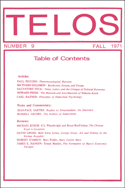 Salvatore Veca’s 1971 essay “Value, Labor, and the Critique of Political Economy” summarizes the treatment of contained and required labor in Adam Smith, David Ricardo, and Karl Marx. Most interesting is the manner in which Veca temporalizes this distinction in political economy. He draws our attention to the opposition between past labor and present, dead labor and living; namely, “the dominance of past, materialized, accumulated labor over immediate, living labor”: Salvatore Veca’s 1971 essay “Value, Labor, and the Critique of Political Economy” summarizes the treatment of contained and required labor in Adam Smith, David Ricardo, and Karl Marx. Most interesting is the manner in which Veca temporalizes this distinction in political economy. He draws our attention to the opposition between past labor and present, dead labor and living; namely, “the dominance of past, materialized, accumulated labor over immediate, living labor”:
Starting from the analysis of the typical character of labor, it is possible to reconstruct towards the surface of the system the progressive stratifications and determinations of a totality which must, however, be traced back to its base, i.e., to that unequal exchange which contaminates the world of commodities and which reveals the class violence, the elementary mechanism of exploitation, and the dominance of dead labor over living labor.
Veca presents the same temporal picture of past and present labor that moved Marx to crisscross Capital with a metaphorical cast of ghostly manifestations, vampires, and the undead. Veca’s paper suggests the extent to which Marx’s range of metaphors is no mere literary conceit, but rather it is a key feature of fundamental theoretical nodes in his critique of political economy. As we shall see, the specter of dead labor has deeper conceptual foundations in Marx’s forerunners, but this idea also has contemporary relevance with reference to present-day philosophical trends.
Continue reading →
|
|
 In his 1933 essay “On the Philosophical Foundation of the Concept of Labor in Economics,” Marcuse’s thesis is that the conception of labor as economic activity gives a one-sided picture of human praxis. According to Marcuse, such a conceptualization overlooks the way in which labor is an eternal condition of human existence geared toward self-creation and becoming. Marcuse’s elucidation of these issues invites contention. As Douglas Kellner asserts in his introduction to the essay, the two principal problems with Marcuse’s position pertain to the way in which labor is, on the one hand, presented as an entirely trans- or a-historical phenomenon, capable only of being “liberated” rather than offering the possibility of being “liberated from,” and, on the other, associated with an absolutized self through the process of labor-as-becoming, holding subjectivity to be forged consciously rather than foisted upon oneself from outside (Kellner, 3–6). To these I would add a related third, which is that an economic perspective such as that challenged by Marcuse is necessary to rectify the first and second stumbling blocks. In spite of this, as we shall see, Marcuse’s theorization of the philosophical and economic conceptualization of labor might provide useful insights for a rethink of productive activity in the context of contemporary capitalism.
In his 1933 essay “On the Philosophical Foundation of the Concept of Labor in Economics,” Marcuse’s thesis is that the conception of labor as economic activity gives a one-sided picture of human praxis. According to Marcuse, such a conceptualization overlooks the way in which labor is an eternal condition of human existence geared toward self-creation and becoming. Marcuse’s elucidation of these issues invites contention. As Douglas Kellner asserts in his introduction to the essay, the two principal problems with Marcuse’s position pertain to the way in which labor is, on the one hand, presented as an entirely trans- or a-historical phenomenon, capable only of being “liberated” rather than offering the possibility of being “liberated from,” and, on the other, associated with an absolutized self through the process of labor-as-becoming, holding subjectivity to be forged consciously rather than foisted upon oneself from outside (Kellner, 3–6). To these I would add a related third, which is that an economic perspective such as that challenged by Marcuse is necessary to rectify the first and second stumbling blocks. In spite of this, as we shall see, Marcuse’s theorization of the philosophical and economic conceptualization of labor might provide useful insights for a rethink of productive activity in the context of contemporary capitalism.  After the Enlightenment attempted to replace the revealed public absolute with a self-grounding universal rationality, an attempt the Counterenlightenment charged with arbitrariness, the historicist discourse tried to establish the narrative of the origin and development of culture as a public, objective absolute that escapes this critique. In this narrative, the Orient functioned as a fetish of origin subserving the disavowal of the lack of grounding that the Enlightenment had introduced. In historicist Orientalism, the Occident appropriated this alien origin by applying the logic of medieval typology—hitherto the principal model for the supersession of Judaism by Christianity—to the Oriental-Occidental relation in general. Historicist Orientalism constituted a typological teleology to assert the supersession of East by West as a quasi-secularized, objective, public absolute. In the anxiety-inducing metaphysical void of modernity, the story of culture provided an “orientation” that revelation failed to deliver. Herder’s Ideas for a Philosophy of the History of Humanity (1784-91) was one of the most important inaugural instances of this historicist Orientalism in the German tradition. The essay retraces the outlines of the problematic logic through which Herder recounted the passage from the origins of culture in Asia to their Western appropriation. Situating the Jews as the realization of the Oriental prefiguration, Herder’s discourse provides an exemplary version of the passage from the Judaeo-Christian application of typology to its Orientalist generalization and secularization.
After the Enlightenment attempted to replace the revealed public absolute with a self-grounding universal rationality, an attempt the Counterenlightenment charged with arbitrariness, the historicist discourse tried to establish the narrative of the origin and development of culture as a public, objective absolute that escapes this critique. In this narrative, the Orient functioned as a fetish of origin subserving the disavowal of the lack of grounding that the Enlightenment had introduced. In historicist Orientalism, the Occident appropriated this alien origin by applying the logic of medieval typology—hitherto the principal model for the supersession of Judaism by Christianity—to the Oriental-Occidental relation in general. Historicist Orientalism constituted a typological teleology to assert the supersession of East by West as a quasi-secularized, objective, public absolute. In the anxiety-inducing metaphysical void of modernity, the story of culture provided an “orientation” that revelation failed to deliver. Herder’s Ideas for a Philosophy of the History of Humanity (1784-91) was one of the most important inaugural instances of this historicist Orientalism in the German tradition. The essay retraces the outlines of the problematic logic through which Herder recounted the passage from the origins of culture in Asia to their Western appropriation. Situating the Jews as the realization of the Oriental prefiguration, Herder’s discourse provides an exemplary version of the passage from the Judaeo-Christian application of typology to its Orientalist generalization and secularization.  Salvatore Veca’s 1971 essay “Value, Labor, and the Critique of Political Economy” summarizes the treatment of contained and required labor in Adam Smith, David Ricardo, and Karl Marx. Most interesting is the manner in which Veca temporalizes this distinction in political economy. He draws our attention to the opposition between past labor and present, dead labor and living; namely, “the dominance of past, materialized, accumulated labor over immediate, living labor”:
Salvatore Veca’s 1971 essay “Value, Labor, and the Critique of Political Economy” summarizes the treatment of contained and required labor in Adam Smith, David Ricardo, and Karl Marx. Most interesting is the manner in which Veca temporalizes this distinction in political economy. He draws our attention to the opposition between past labor and present, dead labor and living; namely, “the dominance of past, materialized, accumulated labor over immediate, living labor”: 